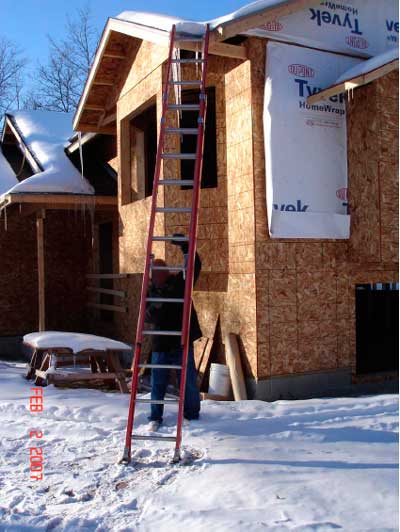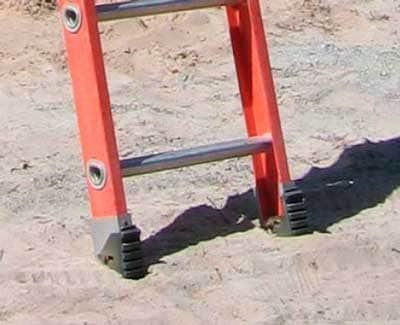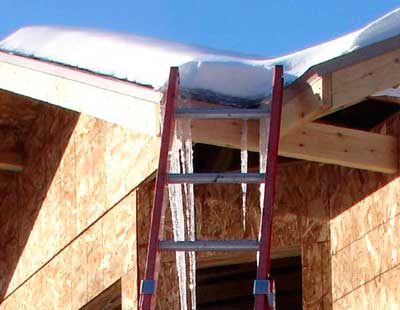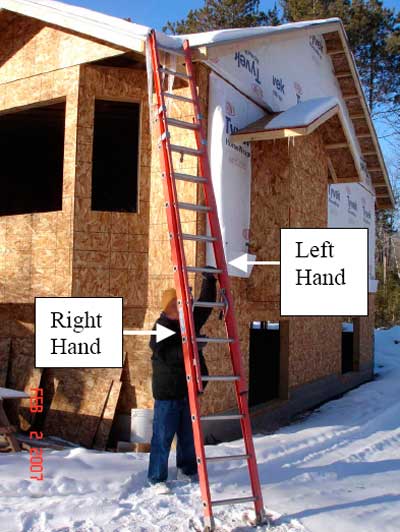Carpenter Dies After Fall From a Ladder That Slipped From Its Base While Positioned on Frozen Sand
Michigan Case Report: 07MI007
Summary
On January 13, 2007, a 43-year-old male carpenter was injured when he jumped/fell from a ladder that slipped away from the drip edge of a house. The decedent positioned the fiberglass extension ladder diagonally across the inside corner of the roof to secure a 2-inch by 4-inch piece of wood to the fascia under the drip edge to protect the drip edge. The ladder’s safety feet were in an up position on the frozen soil. He called to his coworker to hold the ladder while he accessed the roof area. The coworker stood underneath the ladder and held rung #5 with his right hand and rung #7 with his left hand (Figure 1). The decedent climbed the ladder holding the wood, to either rung #8 or #9 when the base of the ladder slipped away from the house. The falling ladder struck the coworker on his shoulder and arm and knocked him to the ground. The decedent fell to the coworker’s left and landed on his back. 911 was called and the decedent was taken to a local hospital. After assessment, the decedent was transported to another hospital where he died six days later.

|
|
Figure 1. Re-enactment of ladder placement and position of individual holding the ladder
|
Recommendations:
- Employers should ensure that ladders are used in accordance with the requirements of existing safety standards and good standard practice.
- Employers should develop and implement a comprehensive written safety program.
- Construction employers should conduct a daily hazard assessment to determine if environmental working conditions have changed or will change. They should inform their employees of their findings and how the changing conditions may affect the work to be performed.
- Employers should consider having at least one person on the jobsite certified in First Aid/CPR, should strongly consider having an individual certified as a Medical First Responder or Emergency Medical Technician (EMT), and hold at least semi-annual workplace rescue/first aid practices.
- MIOSHA Consultation, Education and Training Division and trade associations should continue in their efforts to develop regional safety training programs aimed at disseminating pertinent safety information to individual contractors.
Introduction
On January 13, 2007, a 43-year-old male carpenter was injured after he fell/slipped from a ladder. The base of the ladder that was placed on frozen ground slipped away from the drip edge of a house it was resting against. He died in the hospital six days after the incident due to complications from the injury. On January 29, 2007, MIFACE investigators were informed by the Michigan Occupational Safety and Health Administration (MIOSHA) personnel who had received a report on their 24-hour-a-day hotline that a work-related fatal injury had occurred on January 13, 2007. On April 20, 2007, MIFACE interviewed the coworker who had been holding the ladder at the incident site. During the course of writing this report, the emergency room incident narrative and the MIOSHA file and citations were reviewed. The pictures used in Figures 1, 3, and 4 are courtesy of the MIOSHA file. The picture used for Figure 2 was taken at the time of the MIFACE site visit.
The decedent’s coworker owned an established residential construction company and had employed the decedent as a subcontractor on a part-time basis for seven years. In 2006, the decedent and the coworker formed a limited liability corporation. The decedent was the qualifying officer of this newly formed company, and the coworker was a member of the company. The coworker planned to resign when the limited liability corporation had built up some assets, thus leaving the decedent as the sole owner.
The decedent had 25 years experience as a carpenter. The coworker stated that the decedent’s specialty was truss work. The coworker and decedent would “correct” each other when they noted someone working unsafely. The coworker stated that if an extension ladder was to be used for more than a short period of time, the decedent would place the ladder with the safety feet up and run spikes between the ladder and the safety feet to anchor the ladder to the ground.
Neither the coworker’s company nor the limited liability corporation had a safety and health program. According to the coworker, the decedent was planning to attend a construction safety program the following month that was being offered by a local construction trade group.
At the conclusion of the MIOSHA investigation, the limited liability corporation was issued one Serious and two Other-than-Serious citations:
- SERIOUS:
- FIXED AND PORTABLE LADDERS, PART 11, RULE 1124(2): A portable fiberglass extension ladder was not secured in a manner to prevent it from being displaced.
- OTHER-THAN-SERIOUS:
- GENERAL RULES, PART 1, RULE 114(1): No accident program. Employer has not developed, maintained and coordinated with their employees a written accident prevention that meets the minimum requirements of Rule 408.40114.
- Training which would enable employees to recognize fall hazards and the procedures to be followed to minimize these hazards.
- Training which would enable employees to recognize hazards related to ladders and the procedures to be followed to minimize these hazards.
- OTHER-THAN-SERIOUS:
- ACT 154 PUBLIC ACT OF 1974, RULE 4080.1061(1): Employer failed to notify the Department of Labor and Economic Growth, Michigan Occupational Safety and Health Administration of an accident resulting in the death of an employee.
Investigation
The decedent and the coworker who himself was the owner of a construction company were building a “spec” home. The permits had been obtained in the name of the coworker’s company. The decedent’s company was being subcontracted to perform the construction work. The coworker, who had another full-time job, gave the decedent instructions for the work to be performed for the week. The coworker stated that the decedent had performed the work in a timely manner. The coworker’s company had also hired a worker for one week, and family members to work on the home’s framing.

|
|
Figure 2. Ladder safety feet in the up position
|
The “spec” home had been under construction for approximately one month. The coworker arrived at the site the morning of the incident before the decedent. He removed sheeting on the back (north) side of the house. The decedent arrived at the site at approximately 9:30 a.m. and accessed the roof via existing ladder jacks to sweep off the roof and ready it for further work. While the decedent was on the roof, his coworker discussed various building-related issues with the other contractors on site. After the issues were resolved, the coworker began to prepare for putting the roof cap on the house.
 |
|
Figure 3. Ladder placed diagonally across inside corner
|
While his coworker was changing the knife blade on his utility knife to a hook blade so he could cut shingles for the ridge cap, the decedent set the Type IA fiberglass extension ladder diagonally across the inside corner of the roof to secure a 2-inch by 4-inch piece of wood to the fascia under the drip edge to protect the drip edge (Figure 3). In this incident, the ladder was clean and free of defects that might contribute to the fall. The top of the ladder was almost flush with the roof height. The base material was sand, frozen to a depth of approximately four inches. The pitch of the ladder is unknown. The coworker stated to the MIFACE researcher that the ladder’s safety feet were in the up position and “dug into” the frozen sand (Figure 2 ). Figure 1 and Figure 3 were taken at the time of the MIOSHA compliance officer’s site inspection and are re-enactments of the ladder position and the position of the coworker under the ladder. The sand was not snow-covered at the time of the incident. Figure 2 shows the sand base and the safety feet in the up position. The coworker also re-enacted the incident scenario for the MIFACE researcher, placing the ladder safety feet in the up position and at a similar pitch as in Figure 1 and Figure 4.
 |
|
Figure 4 Re-enactment of the position of the coworker under ladder
|
The decedent called his coworker over to hold the ladder for him while he climbed the ladder to nail the wood in place. As they had been done in the past, the coworker stood under the ladder with his back facing the house and placed his left hand on the rung #7 and his right hand on rung #5 (Figure 4). The decedent, who was wearing his tool belt and carrying the 2-inch by 4-inch piece of wood, ascended the ladder. As the decedent climbed passed his coworker, the coworker turned his head so he would not get sand from the decedent’s shoes in his face. The decedent was above the coworker when the coworker felt a “pressure on his hands.” As the decedent passed him, the coworker sensed the decedent’s weight on the ladder and called out to the decedent that it was too heavy for him. As he called out to the decedent, the ladder base kicked out away from the home and the coworker lost his grip. As the ladder fell, it struck the coworker on his left shoulder and arm and knocked him to the ground. The decedent, perhaps to avoid landing on his coworker, jumped/fell in the opposite direction landing on his back approximately seven feet from the ladder. The wood the decedent was carrying landed near the home. The ladder’s final resting spot was several feet from the home.
The coworker went over to the decedent and talked to him. The decedent was unresponsive but breathing. His coworker attempted to get a response from the decedent but could not. Because the coworker did not have a cell phone on him, he ran to the west side of the house and asked other contractors if they had a cell phone. One of the contractors called 911 while the coworker returned to the decedent and checked for a pulse. The decedent was breathing independently and had a pulse. He stayed at the decedent’s side until the first responders arrived. Emergency response arrived within minutes. Emergency response transported the decedent to a local hospital. After the decedent was stabilized, he was transferred to another hospital for further treatment. He died six days after the injury.
Back to Top
Cause of Death
The cause of death as stated on the death certificate was severe closed head trauma due to or as a consequence of a fall off of a ladder.
Recommendations/Discussion
Employers should ensure that ladders are used in accordance with the requirements of existing safety standards and good standard practice.
MIOSHA Construction Safety Standard, Part 11, Fixed and Portable Ladders contains the State requirements for ladder use. Many organizations have published and/or posted on the Internet safe ladder use practices. Several work practices were identified that could have contributed to this tragic incident. These work-practices are included in the table below.
| Work Practice | Discussion |
| Ladder placement against the house may not have been the appropriate pitch. | A portable ladder’s safest pitch is when the horizontal projected distance from the top support to the base is not more than 1/4 of the vertical distance between these points. The more the base is moved from this position, the greater the risk that it will slip outwards and fall. |
| Ladder was diagonally placed against inside corner of the roof. | The ladder’s stability was most likely compromised when the side rails were placed on a diagonal against the inside corner of the roof to protect the drip edge. |
| Ladder placed on potentially unstable base material (frozen sand). | Although the sand was frozen, it may not have provided a substantial and stable base as required. The safety feet may not have been dug deep enough and may have been anchored into loose sand on the frozen sand surface One method to ensure the ladder’s safety feet were embedded deeply enough in the sand would have been to use a claw hammer to dig two to three inches deep into the surface and then place the safety feet into the hole. |
| Ladder not lashed or held in position. | Ladders should be lashed/secured by attaching ropes or straps to the ladder side rails, not the rungs, onto a stable, fixed object. The base of the ladder could be secured by securing ropes/straps from the ladder side rails to stakes in the ground, using fixed blocks or sandbags, or using ladder stablizers. |
| Ladder not extended three feet past the roofline. | Because the extension ladder length was long enough, the ladder side rails should have been at least three feet or more above the roofline. |
| Individual supporting the ladder standing under the ladder. | The position of the coworker made it difficult to control ladder movement. A better position for an individual to provide ladder support would be to stand in front of the ladder, hold both side rails, and place one foot on the bottom rung of the ladder. |
Employers should develop and implement a comprehensive written safety program.
As a general safety recommendation to reduce the risk of injury, employers should ensure that all employees are trained to recognize and avoid hazardous work conditions. A comprehensive safety program should address all aspects of safety related to specific tasks that both the employer and employee are required to perform. MIOSHA Construction Safety Standard requires employers to develop an accident prevention program and instruct employees in the recognition and avoidance of unsafe conditions. Enforcement of this safety program should reduce and/or eliminate worker exposures to hazardous situations. The safety program should include, but not be limited to, ladder safety, the use of safety equipment, and the recognition and avoidance of fall hazards.
The MIOSHA Consultation Education and Training (CET) Division has developed a sample Safety and Health Program to assist in developing a site-specific program. This program may be downloaded from the MIOSHA websiteexternal icon: www.michigan.gov/mioshastandards. Click on Publications, Forms and Media in the box at the left, then click Sample Plans and Special Programs. Click on Safety and Health Plan link.
Construction employers should conduct a daily hazard assessment to determine if environmental working conditions have changed or will change. They should inform their employees of their findings and how the changing conditions may affect the work to be performed.
A daily hazard assessment of a worksite will provide the tools to determine that the work that can be safely performed and also what work practices may need to be changed to perform the work safely. As part of a hazard assessment, environmental conditions should be evaluated and considered when determining how and when a job should be performed. Environmental conditions can be a factor in work place injuries and fatalities. The decedent most likely recognized that the frozen sand was not a secure base because he asked his coworker to stabilize the ladder as he climbed it. An alternative method to access the roof, such as a scissor lift or scaffold, and following the appropriate safety precautions, would have provided a more secure and reliable method.
Employers should consider having at least one person on the jobsite certified in First Aid/CPR, should strongly consider having an individual certified as a Medical First Responder or Emergency Medical Technician (EMT), and hold at least semi-annual workplace rescue/first aid practices.
Emergencies can and do happen, including personal injuries, sudden illnesses (such as a heart attack), fires, natural disasters (such as tornadoes and floods), and violent acts. Emergency situations require a designated person to be in charge of managing the emergency. This person ought not to be the First Aid/CPR or medical first responder, as his/her attention should be solely devoted to stabilizing the victim of an injury/illness situation.
The American Red Cross defines CPR/First Aid as recognizing and caring for breathing, cardiac, and life-threatening emergencies, such as severe bleeding and sudden illness. CPR/First Aid procedures provide assistance in knowing what action to take if an emergency does arise. One of the emergency issues that arise is that CPR/First Aid training does not address a “rescue” situation.
A certified medical first responder is a person who has completed forty to sixty hours of training in providing care for medical emergencies, such as an injury or illness that poses an immediate threat to a person’s health or life that requires help from a doctor or hospital. A certified first responder has more skill than someone who is trained in First Aid/CPR, but a first responder is not an emergency medical technician (EMT). The American Red Cross professional rescuer courses are designed for people with job-related duties in emergency preparedness and response, including industry response teams who must take action in emergency situations. The American Red Cross Emergency Response course is a comprehensive course designed for training first responders. The course follows the 1995 US Department of Transportation (DOT) First Responder National Standard Curriculum. The medical first responder course is also taught in many community colleges. MIFACE encourages employers to contact these providers to provide First Aid/CPR and medical responder training to their employees. To ensure readiness in the case of a serious workplace injury, the employer should hold at least semi-annual workplace rescue/first aid.
MIOSHA Consultation, Education and Training Division and trade associations should continue in their efforts to develop regional safety training programs aimed at disseminating pertinent safety information to individual contractors.
Many small-sized contractors are unaware of the relevant MIOSHA safety standards that apply to their line of work. Because these individuals may not be members of a trade association, they may not be aware of and may not receive notification of health and safety training provided by the association. This lack of knowledge places them and their employees at a higher risk of having a fatal workplace injury. Government agencies and/or trade associations should develop strategies to identify and provide outreach to these small employers to invite them to attend upcoming safety training programs/seminars. Relevant MIOSHA safety and health standards, basic safety information, and information on how to choose, and where to obtain, personal protective equipment should be covered in these safety seminars.
The coworker indicated there was a building trades group in his area that schedules contractor safety programs for local building contractors. The MIOSHA CET Division presents many health and safety courses, including Part 45, Fall Protection for residential construction and a MIOSHA 10-hour Construction Course held at the MIOSHA Training Institute at Macomb Community College. The MIOSHA 10-hour Construction Course includes an overview of fixed and portable ladders, scaffold and scaffold platforms, and fall protection. The MIOSHA CET Division courses are held at various locations throughout Michigan. MIFACE encourages employers to contact the MIOSHA CET Division to learn about the course schedule and locations. The MIOSHA CET Division web site can be accessed through the Michigan Department of Labor and Economic Growth web siteexternal icon at www.michigan.gov/lara. (Link Updated 4/1/2013) Click on the MIOSHA link located in the box on the left side of the web page, then click on the Consultation, Education and Training link. MIOSHA CET can also be contacted by telephone: 517-322-1809. The MIOSHA Training Institute websiteexternal icon can be found at http://michigan.gov/lara/0,4601,7-154-61256_11407_15317_47430—,00.html (link updated 4/9/2015)
MIFACE encourages these groups to continue their outreach efforts to contact small and medium-sized contractors to educate them about existing safety and health standards and strategies to improve the safety efforts at their worksites. MIFACE encourages contractors to take the time to attend these programs to learn more about safety and how to be proactive in providing a safe work environment for their employees.
References
MIOSHA standards cited in this report may be found at and downloaded from the MIOSHA, Michigan Department of Labor and Economic Growth (DLEG) websiteexternal icon at: www.michigan.gov/mioshastandards. MIOSHA standards are available for a fee by writing to: Michigan Department of Labor and Economic Growth, MIOSHA Standards Section, P.O. Box 30643, Lansing, Michigan 48909-8143 or calling (517) 322-1845.
- DLEG MIOSHA Construction Safety Standard Part 1. General Rules
- DLEG MIOSHA Construction Safety Standard Part 11, Fixed and Portable Ladders
- Laborer Dies After Fall From Ladder in South Carolina. NIOSH FACE Report# 9007.
Internet Address: https://www.cdc.gov/niosh/face/In-house/full9007.html - Self-Employed General Contractor Dies in Fall From Ladder in Massachusetts Massachusetts FACE 93-MA-01.
Internet Address: https://www.cdc.gov/niosh/face/stateface/ma/93ma001.html
Michigan FACE Program
MIFACE (Michigan Fatality Assessment and Control Evaluation), Michigan State University (MSU) Occupational & Environmental Medicineexternal icon, 117 West Fee Hall, East Lansing, Michigan 48824-1315. Internet Address: http://www.oem.msu.edu/MiFACE_Program.aspx. This information is for educational purposes only. This MIFACE report becomes public property upon publication and may be printed verbatim with credit to MSU. Reprinting cannot be used to endorse or advertise a commercial product or company. All rights reserved. MSU is an affirmative-action, equal opportunity employer. 10/22/07 (Link updated 8/5/2009)
MIFACE Investigation Report # 07MI007 Evaluationpdf iconexternal icon (see page 10 of report)
To contact Michigan State FACE program personnel regarding State-based FACE reports, please use information listed on the Contact Sheet on the NIOSH FACE web site Please contact In-house FACE program personnel regarding In-house FACE reports and to gain assistance when State-FACE program personnel cannot be reached.
